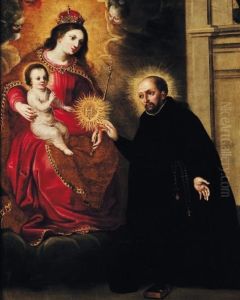Theodor Boyermans Paintings
Theodor Boyermans, born in Antwerp in 1620, was a prominent figure in the Flemish Baroque painting movement, which thrived in the Southern Netherlands during the 17th century. His work is marked by a vigorous Baroque style, emphasizing dramatic movement, vivid coloration, and a robust interpretation of religious and mythological themes, aligning him with the dynamic Counter-Reformation spirit of the era.
Boyermans received his artistic training in the bustling art center of Antwerp, a city renowned for its rich artistic culture and as the home of Peter Paul Rubens, whose influence is evident in Boyermans' work. Although details about his early training are scarce, it is known that he became a master in the Antwerp Guild of St. Luke in 1641, indicating his acceptance and recognition as a professional painter by his early twenties.
Throughout his career, Boyermans developed a distinct style characterized by a strong use of chiaroscuro and a dynamic composition, elements that made his paintings resonate with emotional depth and dramatic intensity. His subjects often delved into religious themes, reflecting the Catholic Counter-Reformation's emphasis on art as a vehicle for spiritual engagement and moral instruction. Boyermans also painted mythological scenes and portraits, demonstrating versatility across genres.
Despite his considerable talent and contributions to the Flemish Baroque, Boyermans did not achieve the same level of fame as contemporaries such as Rubens or Anthony van Dyck. However, his works were appreciated by patrons during his lifetime, and he received commissions from various religious institutions and notable individuals in Antwerp and beyond.
Theodor Boyermans' legacy is preserved in several important collections and museums, including the Royal Museum of Fine Arts in Antwerp. His works continue to be studied for their contribution to the Baroque movement, offering insights into the vibrancy and complexity of 17th-century Flemish art. Boyermans passed away in Antwerp in 1677, leaving behind a body of work that, while not as widely recognized as some of his peers, remains an essential part of the Flemish Baroque tradition.
